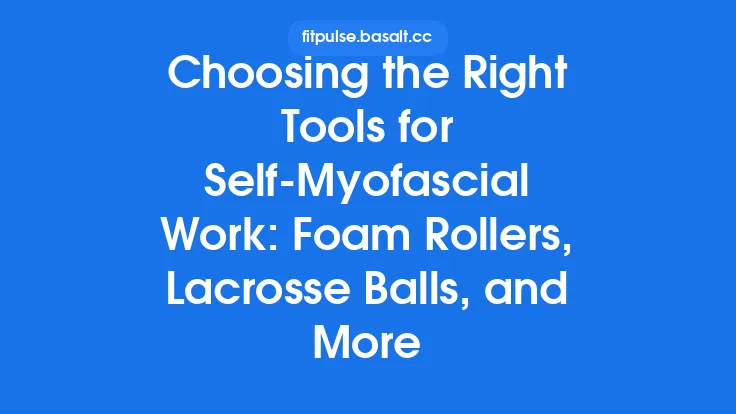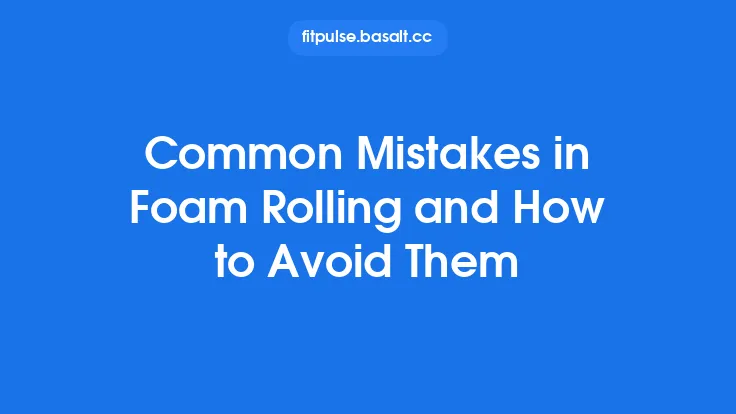When it comes to self‑myofascial release, the foam roller you select can feel like a small piece of equipment, but its specifications dramatically influence how effectively you can target tightness, improve tissue quality, and stay consistent with your recovery routine. The market is flooded with rollers that differ in density, size, and material, and each of these variables interacts with your body’s biomechanics, training volume, and personal comfort thresholds. This guide walks you through the three core attributes—density, size, and material—so you can match a roller to your unique needs, avoid common pitfalls, and get the most out of every roll.
Understanding Foam Roller Density
What “density” really means
Density refers to the firmness of the foam, which is determined by the type of polymer used, the manufacturing process (e.g., injection‑molded vs. cut‑from‑block), and the foam’s cell structure (open‑cell vs. closed‑cell). In practical terms, density translates to how much pressure the roller exerts on your muscles for a given amount of body weight.
| Density Level | Typical Hardness (Shore A) | Sensation | Ideal Use Cases |
|---|---|---|---|
| Soft (≈ 30–45) | Low | “Cushiony,” easy to sink into | Beginners, rehab patients, highly sensitive areas (e.g., neck, upper back) |
| Medium (≈ 45–55) | Moderate | Balanced pressure, still forgiving | General fitness enthusiasts, moderate‑intensity athletes |
| Firm (≈ 55–70) | High | “Hard,” deep pressure with minimal give | Advanced athletes, deep‑tissue work, larger muscle groups (quads, calves) |
How density affects tissue loading
A softer roller distributes force over a larger surface area, reducing peak pressure points. This is beneficial when you need to avoid excessive discomfort or when you’re working on delicate fascia. Conversely, a firmer roller concentrates force, allowing you to reach deeper layers of the myofascial tissue. However, too much firmness can trigger a protective muscle contraction, limiting the duration of the roll and potentially causing micro‑trauma if used improperly.
Choosing the right density for your stage
- Rehabilitation Phase – Start with a soft or medium density to promote blood flow without aggravating inflamed tissue.
- Progressive Loading – As tolerance builds, transition to a medium‑firm roller to increase mechanical stress and stimulate collagen remodeling.
- Performance Optimization – For athletes seeking maximal fascial release, a firm roller is often the most efficient, provided they can maintain proper form.
Size Matters: Length and Diameter Considerations
Length: Coverage vs. Portability
- Standard (36–42 in) – Offers full‑body coverage, allowing you to roll large muscle groups (hamstrings, back) without repositioning. Ideal for home gyms or dedicated recovery spaces.
- Compact (24–30 in) – Easier to store, travel‑friendly, and works well for targeted work on arms, calves, or forearms. May require more frequent repositioning for longer muscles.
- Mini (12–18 in) – Designed for pinpoint work (e.g., foot arches, forearm flexors). Not suitable for large‑area rolling but excellent for trigger‑point release.
Diameter: Width Influences Pressure Distribution
| Diameter | Approx. Pressure per Square Inch (at 150 lb) | Typical Use |
|---|---|---|
| 4 in (small) | High – concentrated pressure | Targeted trigger points, small muscle groups |
| 6 in (medium) | Moderate – balanced pressure | General full‑body rolling, most users |
| 8–12 in (large) | Low – broad pressure | Sensitive individuals, spinal work, beginners |
A larger diameter spreads the load, making the roll feel gentler, while a smaller diameter concentrates force, which can be uncomfortable for novices but highly effective for deep tissue work once technique is mastered.
Matching size to body dimensions
- Tall athletes (>6 ft) often benefit from a 42‑in roller to avoid “short‑rolling” where the ends of the roller don’t reach the full length of the muscle.
- Smaller individuals (<5’5”) may find a 36‑in roller more manageable, especially when rolling on the floor where space is limited.
- Gym‑goers with limited storage might prioritize a 30‑in, medium‑diameter roller that balances coverage and footprint.
Material Choices and Their Implications
Common Foam Types
| Material | Manufacturing Process | Key Characteristics | Pros | Cons |
|---|---|---|---|---|
| EVA (Ethylene‑Vinyl Acetate) | Injection‑molded | Closed‑cell, uniform density | Durable, consistent hardness, resistant to moisture | Can feel “plastic‑like” if too firm |
| Polyethylene (PE) | Extruded, cut from block | Open‑cell, softer feel | Light, affordable, good for beginners | Prone to compression set over time |
| NBR (Nitrile Butadiene Rubber) | Molding, often combined with foam | Hybrid firmness, slightly rubbery surface | Excellent grip, high durability | Higher cost, may retain odor |
| PVC‑Coated Foam | Foam core with PVC outer layer | Smooth surface, easy to clean | Hygienic, resistant to sweat | Less breathable, can feel slippery when wet |
Surface Texture: Smooth vs. Textured
- Smooth rollers provide uniform pressure, ideal for beginners and for rolling over large, flat muscle groups.
- Textured rollers (e.g., ridges, knobs, “spike” patterns) create focal points that intensify pressure on specific fascial lines. They can accelerate release of tight spots but also increase the risk of bruising if used aggressively.
Environmental and Health Considerations
- Odor resistance: Some low‑grade foams emit a lingering “plastic” smell, especially when new. Look for “low‑odor” or “odor‑free” certifications.
- Non‑toxic certifications: Ensure the roller is free from phthalates, BPA, and other harmful additives (look for “ISO 9001” or “REACH compliant” labels).
- Recyclability: EVA and PE foams are generally recyclable; PVC‑coated rollers are less eco‑friendly.
Matching Roller Characteristics to Your Goals
| Goal | Recommended Density | Ideal Length | Preferred Diameter | Surface Texture |
|---|---|---|---|---|
| General mobility & recovery | Medium (45–55 Shore A) | 36–42 in | 6 in | Smooth or mild ridges |
| Deep‑tissue release for athletes | Firm (≥55 Shore A) | 36–42 in | 4–6 in | Aggressive knobs or spikes |
| Rehab after injury / post‑surgery | Soft to medium (30–50 Shore A) | 24–30 in (easier to control) | 8–12 in | Smooth |
| Travel or on‑the‑go routine | Medium (balanced) | 24–30 in | 6 in | Smooth (easier to pack) |
| Targeted trigger‑point work | Firm (≥55 Shore A) | Mini (12–18 in) | 4 in | Textured (knobs) |
Practical decision flow
- Assess your current tolerance – If you’re new to foam rolling, start with a soft, larger‑diameter roller.
- Define the primary muscle groups – Large muscles (quads, glutes) benefit from longer rollers; smaller muscles (forearms, calves) can be served by compact models.
- Determine the environment – Home gyms with ample floor space can accommodate longer rollers; cramped apartments may require a shorter, more portable option.
- Consider budget vs. longevity – Higher‑density EVA or NBR rollers cost more upfront but retain firmness longer, reducing the need for replacement.
Budget and Quality: What to Look For
- Price brackets:
- Entry‑level (under $20): Typically PE foam, soft to medium density, basic smooth surface.
- Mid‑range ($20–$45): EVA or hybrid foam, better density consistency, optional textures, often include a carrying strap.
- Premium ($45+): High‑density NBR or dual‑layer constructions, advanced textures, anti‑odor treatments, and sometimes a warranty.
- Warranty and return policy: A 1‑year warranty indicates confidence in material durability. Look for “no‑questions‑asked” return windows—important if the roller feels too hard or soft after a trial.
- User reviews for compression set: Search for comments about “hardening” or “flattening” after a few months. Foam that maintains its original shape is a sign of quality.
Maintenance and Longevity
- Cleaning: Wipe down after each use with a mild soap solution. For textured rollers, a soft brush can dislodge debris lodged in ridges.
- Drying: Air‑dry completely before storage to prevent mold, especially for foam with open cells.
- Storage: Keep in a cool, dry place away from direct sunlight; UV exposure can degrade polymer bonds, making the foam brittle.
- Rotation: If you own multiple rollers (e.g., a soft and a firm one), rotate usage to extend the life of each by reducing constant high‑pressure exposure on a single unit.
Putting It All Together: A Decision Framework
| Step | Question | Guideline |
|---|---|---|
| 1 | What is your primary purpose? | Recovery → medium density; deep release → firm density; rehab → soft density |
| 2 | Which muscle groups will you target most? | Large → ≥36 in; small → ≤30 in |
| 3 | How sensitive is your fascia? | High sensitivity → larger diameter, softer foam; low sensitivity → smaller diameter, firmer foam |
| 4 | What is your training environment? | Home gym with space → longer roller; apartment or travel → compact roller |
| 5 | What is your budget? | Allocate more for durability if you plan frequent, high‑intensity use |
| 6 | Do you have any material preferences? | Allergy or odor concerns → choose low‑odor EVA or PE; eco‑concern → recyclable foam |
| 7 | Test before you buy (if possible). | Apply body weight on a demo roller; you should feel firm enough to engage tissue but not so hard that you can’t maintain the position for 30–60 seconds. |
By systematically evaluating each attribute—density, size, and material—you can select a foam roller that not only matches your current needs but also scales with your progress. The right roller becomes a reliable partner in your soft‑tissue toolkit, delivering consistent pressure, durability, and comfort throughout every stage of your training journey.





